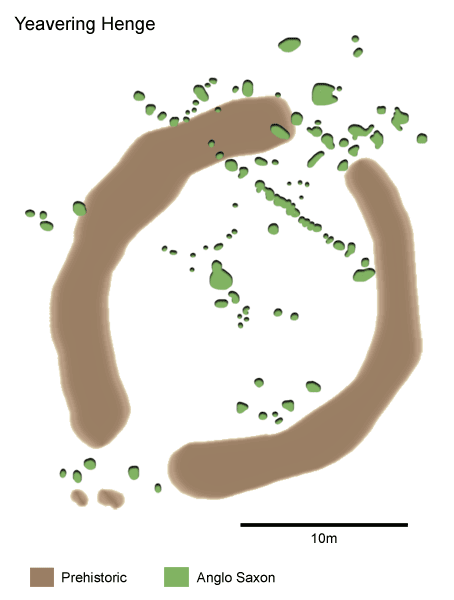Excavations 1976
Once the importance of the Ad Gefrin had been confirmed through excavation in the 1950’s, aerial surveillance increased in the hope of identifying additional features. Significant discoveries were made, including rectangular buildings to the south of the road showing the early medieval settlement to have covered most of the knoll, and enclosures of uncertain though probably prehistoric date on the lower slopes.
 In 1962 Dr St Joseph photographed, from the air, a large ovoid enclosure at the eastern edge of the knoll. Its single broad ditch and opposed entrances to east and west identified it as a henge, a temple of late Neolithic/Early Bronze Age date.
In 1962 Dr St Joseph photographed, from the air, a large ovoid enclosure at the eastern edge of the knoll. Its single broad ditch and opposed entrances to east and west identified it as a henge, a temple of late Neolithic/Early Bronze Age date.
 A little further to the east and below the henge was a Standing-Stone, similarly of late Neolithic/early Bronze Age date. In July 1976 Dr Anthony Harding of Durham University excavated it over three weeks as part of his wider study of the henges of the Milfield Basin. But rarely do excavators discover only what they are looking for, and so proved to be the case here.
A little further to the east and below the henge was a Standing-Stone, similarly of late Neolithic/early Bronze Age date. In July 1976 Dr Anthony Harding of Durham University excavated it over three weeks as part of his wider study of the henges of the Milfield Basin. But rarely do excavators discover only what they are looking for, and so proved to be the case here.
He discovered a number of pits much earlier in date than the henge. One pit contained over 700 sherds of pottery. Of a style we label Carinated Bowl Ware, these cups and round-based bowls were being made by the earliest agricultural communities. In all likelihood a small group were settled here at the site living in post-built wooden houses over 5,500 years ago.
By around 2000BCE a large temple had been built for ritual gatherings and for burial. Its interior was defined by a broad ditch 3m in width with the upcast forming a bank around the outside. It had two wide entrances; one to the west and one to the east. Just outside the western entrance was a grave containing a contracted inhumation with head to the south and facing into the entrance.
Although pits and post-holes were found scattered across the excavated area in no particular order, a line of close-set post-pits identifies an earlier fence boundary. Early medieval material found within the fill of some of the post-pits point to this fence as being part of the early medieval settlement at the site. These included fragments of crucible from metal-working and a loom-weight, suggesting that this part of the site may have been reserved for industrial use. This would be prudent positioning for metal-working and its associated fires given the number of thatched buildings nearby and a wind direction predominantly from the north-west.
